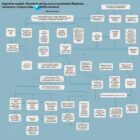Why Are Certain Qualifications Required for Medicaid Application?

Do you ever wonder why certain qualifications are necessary when applying for Medicaid?
The answer lies in the purpose of these requirements. By establishing specific criteria, Medicaid aims to ensure the equitable distribution of resources, prevent abuse and fraud within the system, effectively manage limited funding and resources, and ultimately target assistance to those in the greatest need.
Understanding the reasoning behind these qualifications is crucial in comprehending the complexities of the Medicaid application process.
Key Takeaways
- Medicaid qualifications are required to ensure equitable distribution of resources and prevent abuse and fraud within the system.
- These qualifications also help manage limited funding and resources by carefully allocating funds, implementing cost containment measures, and promoting preventive care.
- Medicaid qualifications target assistance to those in the greatest need by establishing specific eligibility criteria and prioritizing individuals and families facing financial and health-related challenges.
- The qualifications consider factors such as age, disability, and medical conditions in order to bridge the gap between affordability and access to healthcare services.
Purpose of Medicaid Qualifications
To understand the purpose of Medicaid qualifications, it’s important for you to know why certain requirements are necessary for the application process. Medicaid is a government-funded program that provides healthcare coverage to low-income individuals and families. The qualifications for Medicaid are designed to ensure that those who truly need assistance receive it, while also preventing abuse and fraud within the system.
One of the main purposes of Medicaid qualifications is to determine eligibility based on income. Since Medicaid is intended for individuals and families with limited financial resources, there are income limits in place to ensure that assistance is targeted towards those who need it most. These income limits vary by state and are often adjusted to reflect the cost of living in each area.
Another purpose of Medicaid qualifications is to assess an individual’s assets. Medicaid is a need-based program, which means that applicants must meet certain asset limits. This is done to prevent individuals from transferring or hiding their assets in order to qualify for Medicaid. By evaluating an applicant’s assets, Medicaid can determine if they genuinely require assistance.
Additionally, Medicaid qualifications also consider an individual’s citizenship or immigration status. To be eligible for Medicaid, applicants must be either U.S. citizens, U.S. nationals, or qualified immigrants. This requirement is in place to ensure that Medicaid benefits are provided to those who are legally entitled to them.
Ensuring Equitable Distribution of Resources
One way to ensure equitable distribution of resources for Medicaid applicants is by implementing fair and consistent eligibility criteria. This ensures that individuals who truly need Medicaid’s assistance can access it, while also preventing abuse and misuse of the program.
Here are three important factors to consider in establishing equitable distribution:
- Income-based criteria: Medicaid eligibility is often determined based on income levels. By setting income thresholds that are fair and consistent, individuals with similar financial situations can receive the same level of assistance. This helps prevent wealthier individuals from taking advantage of the program and ensures that limited resources are allocated to those who need them most.
- Needs-based assessment: In addition to income, Medicaid eligibility criteria may also consider an individual’s medical needs. This ensures that those with chronic illnesses or disabilities receive the necessary support and resources. By focusing on the specific needs of applicants, the program can effectively distribute resources in a way that addresses the most pressing healthcare concerns.
- Regular review and updates: Eligibility criteria should be periodically reviewed and updated to reflect changing economic conditions and healthcare needs. This ensures that the program remains responsive and adaptable, providing assistance to those who need it the most. Regular reviews also help identify any potential loopholes or inconsistencies in the criteria, allowing for necessary adjustments to maintain equitable distribution.
Preventing Abuse and Fraud in the System
Prevent Medicaid abuse and fraud by implementing robust monitoring and verification systems. Medicaid is a vital program that provides healthcare coverage to millions of low-income individuals and families. However, like any government program, there is always a risk of abuse and fraud. To safeguard the integrity of the system, it is crucial to have effective measures in place to detect and prevent any fraudulent activities.
One way to address this issue is through the implementation of robust monitoring and verification systems. These systems can help identify suspicious patterns and behaviors, allowing for timely intervention and investigation. By constantly monitoring Medicaid claims, providers, and beneficiaries, potential instances of abuse and fraud can be detected and addressed promptly.
Below is a table outlining key strategies to prevent Medicaid abuse and fraud:
| Monitoring and Verification Strategies | Examples |
|---|---|
| Data analytics | Analyzing claims data to identify anomalies or patterns of abuse |
| Provider audits | Conducting audits to verify the accuracy and legitimacy of provider claims |
| Beneficiary eligibility checks | Verifying the eligibility of individuals applying for Medicaid |
| Fraud hotlines | Establishing hotlines for reporting suspected cases of fraud |
| Collaboration with law enforcement | Working closely with law enforcement agencies to investigate and prosecute fraud cases |
Managing Limited Funding and Resources
Managing limited funding and resources is crucial for ensuring the sustainability and efficiency of the Medicaid program, especially in the face of potential abuse and fraud. As Medicaid aims to provide healthcare coverage to low-income individuals, effective management of limited funds becomes paramount. Here are three key strategies for managing limited funding and resources in the Medicaid program:
- Budget Allocation: The Medicaid program must carefully allocate its limited funds to cover the healthcare needs of eligible individuals. This involves setting priorities, determining the appropriate level of coverage, and making strategic decisions to optimize resource utilization.
- Cost Containment Measures: Implementing cost containment measures is essential to ensure that Medicaid funds are used efficiently. This includes strategies such as negotiating lower prices for medications and medical services, implementing utilization review programs to reduce unnecessary treatments, and promoting preventive care to mitigate the need for costly interventions.
- Data Analysis and Monitoring: Regular analysis and monitoring of Medicaid spending and utilization patterns can help identify areas of potential waste or abuse. By analyzing data on a regular basis, program administrators can make informed decisions to address inefficiencies and ensure that resources are being used effectively.
By effectively managing limited funding and resources, the Medicaid program can maximize its impact and better serve the population in need.
This sets the stage for the next section, which focuses on targeting assistance to those in greatest need.
Targeting Assistance to Those in Greatest Need
To ensure that assistance is provided to those in greatest need, certain qualifications are required for Medicaid application. The purpose of these qualifications is to target the limited resources and funding available to those who require it the most. By establishing specific eligibility criteria, the Medicaid program aims to prioritize individuals and families who face the greatest financial and health-related challenges.
One of the main qualifications for Medicaid is based on income level. This is because individuals with lower incomes often struggle to afford healthcare and medical expenses. By targeting assistance to those with limited financial resources, Medicaid helps bridge the gap between affordability and access to healthcare services.
In addition to income, other qualifications may include factors such as age, disability, and family composition. These criteria further ensure that assistance is provided to specific groups who are more vulnerable and in need of support. For example, Medicaid may prioritize pregnant women, children, and individuals with disabilities, as they often require specialized medical care and have increased healthcare needs.
Frequently Asked Questions
What Are the Income Limits for Medicaid Eligibility in Each State?
In each state, there are income limits for Medicaid eligibility. These limits vary and depend on factors such as household size and income level. It is important to check the specific guidelines for your state to determine eligibility.
Can Someone With Pre-Existing Conditions Qualify for Medicaid?
Yes, someone with pre-existing conditions can qualify for Medicaid. The program takes into account various factors, such as income and disability status, to determine eligibility. Qualification requirements may vary by state.
Are There Any Exceptions to the Medicaid Asset Limits?
Yes, there are exceptions to the Medicaid asset limits. These exceptions vary by state and may include certain types of property, such as a primary residence or a car. It’s important to check your state’s specific guidelines.
Are There Any Specific Requirements for Elderly Individuals to Qualify for Medicaid?
To qualify for Medicaid, elderly individuals must meet specific requirements. These qualifications are in place to ensure that those who truly need assistance receive it. They help determine eligibility based on income, assets, and other factors.
How Does Medicaid Eligibility Differ for Pregnant Women?
Medicaid eligibility for pregnant women differs from other groups. You must meet income and resource requirements, but some states have higher income limits for pregnant women. Additionally, pregnancy-related expenses may be covered even if you don’t meet the regular eligibility criteria.



